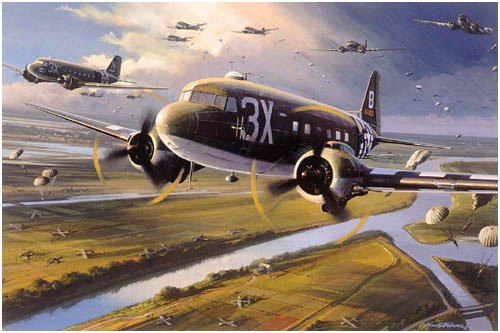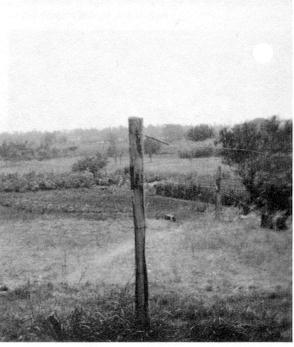|
Posted on 08/14/2003 3:27:48 AM PDT by snippy_about_it
|
|
 are acknowledged, affirmed and commemorated.
|

  Restored Waco CG-4A on display at the USAF Museum Wright-Patterson AFB. Note the skids under the nose. These replaced the nose wheels found on powered aircraft. The engineless glider was towed by a C-47 transport plane until over its landing zone, when the tow plane would release a three-hundred-foot nylon towrope, and the glider made what amounted to a crash landing.  "At an airfield in Britain a C-47 transport snatches up a CG-4A glider. The glider's towline was suspended between two poles, and the transport flew over them trailing a long hook. The hook picked up the line a fraction of a second before this picture was taken, and the plane is now opening its throttles and taking up the slack. Within a second or two the glider will jerk forward and be pulled over the two posts as it goes."  This CG4A Glider from Atterbury Army Air Field didn't quite make it back and landed in Perry Doup's farm field at the corner of the base in 1945. It was "snatched" out of the field by a C-47 tow plane. Gliding was a dangerous and thankless job. In training alone, from May 1943 to February 1944, there were 162 injuries and seventeen deaths due to glider accidents. Many more men would die when their gliders cracked up on the landing zones of Europe.  A burned out CG-4A Glider that had a Jeep on board and what appears to be a fatality under the burned out wing spar. Note the helmets in the wreckage. Also know as "Glider Riders" or "The Towed-Target Infantry," the Glider Infantry rode gliders into combat, flying in the same sky as their paratrooper comrades but, for some time, they were excluded from the hazard pay the paratroops received. Eventually, and after casualties proved otherwise, it became apparent that riding a glider was often more hazardous than jumping. This injustice was corrected and in July 1944 the glidermen receive their well-earned hazardous-duty pay (although it was half what the paratroopers received) and the right to wear glider wings.  The squadron code 8Y is of the 96th Troop Carrier Squadron of the 440th Troop Carrier Group of the 50th Troop Carrier Wing. The 96th TCS was stationed at Exeter, England, home base of the 50th TCW. When asked, most paratroopers preferred jumping to riding a glider. This was easy to understand since Glider Pilots and Glider Infantry wore no parachutes in combat missions. The added weight of the parachutes meant that fewer troops and supplies could be carried in each glider. Although considered airborne soldiers, glider troops were uniformed and equipped similar to regular infantry troops, the same wool uniform, M1941 field jacket, M1943 combat boots and leggings. Along with the ammo cartridge belt, they carried the general purpose ammunition bag, designed for 19 different ammunition items and grenades. This bag was widely used by the airborne forces.  Paratroopers preparing for the mission. Note the rare pistol grip 30-caliber carbine the trooper has slung over his shoulder The differences in uniforms was a continuing sore point with the glider troops. The prestige of the jump boots were so strong that in 1943 the commanding general of the 82nd, authorized his staff to wear them if they undertook a single parachute jump, (without completing full jump training). The 505th Parachute Infantry Regiment, in retaliation, posted a notice that any paratrooper making a single glider landing was authorized to wear shoes and leggings!  Glider Troops before the Holland invasion mission These troopers consistently distinguished themselves in combat. As one veteran Glider Pilot explained after visiting this site, "You are very generous in your praise of the Glider Pilots but the real heroes were the Glider Troopers who were not volunteers but who covered themselves with glory in combat. For example: The 325th Glider Infantry Regiment of the 82nd Airborne Division received the Presidential Unit Citation for an outstanding combat record in Normandy. The Glider Troops were the equal of anybody on the ground."  September 23, 1944 photo of a jeep being loaded into a CG4-A Glider before the Holland invasion.  Glider Pilots just one half hour before their take-off for the invasion of Holland  The 3rd Battalion, 327th Infantry Regiment was first organized on 17 September 1917 at Camp Gordon, Georgia as an element of the 82nd Division. One year later, having arrived in France as a part of the American Expeditionary Force, the battalion participated with the regiment in the St. Mihiel Offensive. This proved to be the first operation in World War One conducted entirely by American units. The battalion also participated in the final Allied Offensive of the war in the Meuse-Argonne sector during early November 1918. During this operation, the battalion earned the honor of being part of the first regiment to reach and pierce the Kriemhilde Stellung, Germany's last defensive line on the Western front. Following the conclusion of the war, the unit was demobilized at Camp Upton, New York on 26 May 1919, and later reconstituted in the Organized Reserves in South Carolina on 24 June 1921. With the involvement of the United States in the Second World War, the battalion was ordered to active military service on 15 August 1942 under the colors of a new unit. Serving as the 1st Battalion, 401st Glider Infantry Regiment, it immediately joined the 101st Airborne Division at Camp Claiborne, Louisiana upon activation. It then trained with the division at Fort Bragg, North Carolina for a year prior to sailing for England on 5 September 1943. Shortly thereafter, the 401st Glider Infantry Regiment was split in two and the 1st Battalion was provided as a temporary third battalion to the 327 Glider Infantry Regiment.  "Glider Attack on D-Day. Some American glidermen in both Horsas and CG-4As having already landed, more gliders continue to cut loose to commence their attack." On 6 June 1944, following months of extensive preparation and intense training in England, the battalion entered combat as a part of Operation Overlord, the invasion of Normandy and Nazi-occupied France. Arriving by amphibious assault on the afternoon of D-Day, the unit moved from Utah Beach to secure vital areas inland from the invasion beaches. It later participated in the attack on Carentan and, despite many casualties, accomplished its mission. The battalion returned to England on 13 July 1944.  Brigadier General Anthony C. McAuliffe, artillery commander of the 101st Airborne Division, gives his various glider pilots last minute instructions before the take-off on D plus 1. England. National Archives Photo The 1st Battalion, 401st Glider Infantry Regiment was next committed to action in Operation Market-Garden, the daring airborne invasion of Holland, on 18 September 1944. Landing by glider, it soon moved to seize and defend a portion of highway between Eindhoven and St. Oedenrode, so as to enable British armored units to advance towards the city of Arnhem. It saw its heaviest fighting of the campaign during the Battle of Opheusden from 6 October to 14 October 1944, and continued to battle German forces in the area until relieved from combat in order to rest and refit. The battalion then moved to Camp Mourmelon, France in late November. From this peaceful state, the battalion was alerted to participate in what would ultimately become its bloodiest two months of combat - the Battle of the Bulge. Shortly after its arrival at the vital crossroads city of Bastogne, Belgium on 19 December 1944, the entire 101st Airborne Division was surrounded by elements of the German 5th and 7th Panzer Armies. On 22 December, the commander of the German 47th Panzer Division Corps sent a note through the lines to Brigadier General Anthony McAuliffe, Acting Division Commander, demanding the surrender of the 101st. General McAuliffe replied to the ultimatum with his now famous statement: "NUTS!" The besieged Bastogne garrison continued to hold out receiving supplies via air drops and glider landings, until the encirclement was broken on 26 December. For its valiant actions in the defense of Bastogne, the 1st Battalion, 401st Glider Infantry Regiment was awarded it first Presidential Unit Citation. This heroic enagagement also earned the 327th the nickname "Bastogne Bulldogs."  "Stars and Stripes" 8 June 1944 Front Page "Air Train 200 Mi. Long Takes Troops to France." In March 1945, combat gliders flew in their last major mission in the European war in "Operation Varsity," the first airborne assault onto German soil and the costliest for the Glider Pilots. 1,348 gliders took part in this airborne drop. On the first day of the assault, March 24, 1945, the Glider Pilots suffered their highest one-day casualty rate -- 78 killed. Before the mission ended, a total of 80 Glider Pilots were killed and approximately 240 were wounded. Many Glider Pilots who took part in this mission had survived the dangers of several previous missions only to lose their lives in this final airborne assault into the teeth of massed German forces defending their soil. This offensive was one of the final, major blows to the Nazi regime and hastened the German retreat. The European war ended the next month. On 8 May 1945, the war ended with the battalion in the vicinity of Hitler's famous "Eagle's Nest."  Troops on the ground with British Horsa Glider landing overhead "Operation Varsity". In June 1945, in "Mission Appari," American Glider Pilots delivered 11th Airborne Division troops to northern Luzon in the Philippines. This was the first and last glider mission in the Pacific and the last glider mission of WWII. Notably, it was the first and last combat mission for a larger version of the Waco CG-4A, the CG-13A, twice as large and able to carry twice as many troops and far more equipment. The U.S. combat glider program was initiated during World War II. These men had been engaged in the risky activity of flying unarmed and unpowered aircraft built of steel tubing, cloth and plywood across enemy lines.  These gliders were flown with heavy loads, and were capable of carrying a jeep loaded with supplies, or 16 men. Though many today remain unaware that there ever was a Glider Corps, to historians and military buffs the activities of this group are legendary. When the topic is discussed, the conversation inevitably turns to the bravery and/or the questionable sanity of the men who willingly participated in such activity.      |



Hey! You been taking classes on the side? :-(







Of course the Germans used Gliders in Belgium in 1940 to capture Fortress Eben-Emael on the Albert Canal from the air.
Disclaimer: Opinions posted on Free Republic are those of the individual posters and do not necessarily represent the opinion of Free Republic or its management. All materials posted herein are protected by copyright law and the exemption for fair use of copyrighted works.